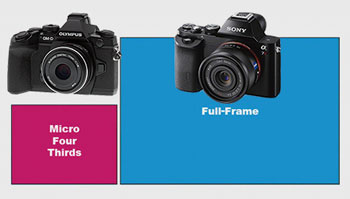Size and weight are the big selling points of Micro Four Thirds. But with the full-frame mirrorless Sony A7/A7R system cameras becoming reality, will there anyone still seriously insist that Micro Four Thirds is compelling on a size/weight basis?

Heresy?
There are different cases to strengthen and weaken this argument. But let’s look at one real-world case, and small differences in size and weight are just not relevant to the core idea which is that the weight difference is more modest than one might think.
Compare the size and weight:
- Sony A7R: 465g with battery and card + 120g for the Zeiss 35mm F2.8 lens.
- Olympus E-M1: 497g with battery and card + 120g for the Olympus 17mm F1.8 lens.
Don’t get me wrong. I have a very soft spot for Olympus. Let’s just look at the facts. And I’m quoting Lloyd Chambers:
Wow. The Sony A7R full-frame camera with equivalent lens is lighter than the equivalent Olympus E-M1 Micro Four Thirds setup.
Actually, the F2.8 lens on full-frame would have to be F1.0 (!) on Micro Four Thirds to be equivalent in depth of field and blur potential. So the Sony wins there also.
Oh, and the Sony A7R has 36MP in which each of those pixels is larger in area than the 16MP of the E-M1. 2.25x the pixels in 3.8 times the area = more and larger and higher quality pixels.
Case closed for anyone looking for image quality at similar size/weight equivalence, at least for the ~35mm focal length.
Well? Right, the lenses are Micro Four Thirds’ big plus. So drop those awkward zooms and go prime.


